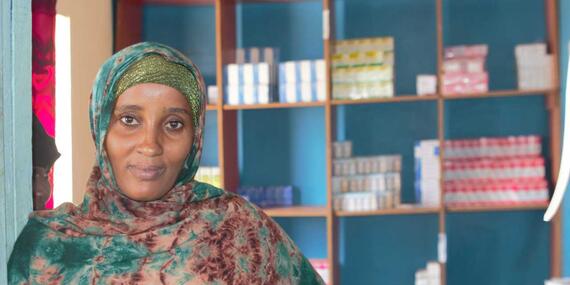Kenya: Local volunteers help malnourished children amid severe drought

Story and photos by Sofia Marri
The town of Merti, in east Kenya, shows warning signs of the devastating drought that has ravaged communities across the Horn of Africa since late 2020. Animal carcasses are scattered along the road, the landscape is barren as far as the eye can see, and small rivers that once flowed are now dry.
Dokatu, a nutritionist at Merti Hospital, and a team of 10 health workers provide health and nutrition services to a community of more than 45,000 people amid basic healthcare facilities and a shortage of services.
“There are many malnutrition cases in the area,” says Dokatu. “Available nutrition supplements are not enough to treat all cases, and we don’t have specific treatment for patients who are both malnourished and live with HIV, AIDS or tuberculosis.”
She also explains that mothers skip meals to save food for their family.
Lack of food is not the only problem facing the town. Merti has no access to clean water, and people rely on a few boreholes and water trucking. But the trucking is affected due to a growing water shortage, meaning the hospital now receives water only twice a week, instead of daily.
As well as adapting to a limited water supply, health workers must also contend with increasing cases of malaria, malnutrition and other health issues.
Relapsing cases of malnutrition are common in the area, as most families don’t have enough food once they’re released from hospital. Against all those odds, Dokatu and the team treated 500 malnourished children and pregnant and breastfeeding mothers in 2022.
This year, the team managed an even better success rate: every child who they’ve treated for malnutrition has recovered.
Those responsible for this success are people like Diramu, a community volunteer in Basa, who makes door-to-door visits every month to screen children and nursing women for malnutrition, and to refer malnourished people for treatment.
“I decided to become a health volunteer when I saw the distress of my neighbour who could not get medical assistance,” Diramu says. “I wanted to do something to help my community.”
Nathan is a nurse and the team leader in Merti Hospital. Together with Dokatu and the team, he trains local volunteers, like Diramu, in identifying malnutrition and educating communities on treatment and prevention.
Mothers and caregivers learn how to identify early signs of malnutrition in their children by using a special mid-upper arm circumference measuring tape. Dokatu explains: “We started using this method during COVID-19, when direct contact was not possible.”
But even after the pandemic, the team kept training their community, as they realized they could reach more people and raise awareness this way. “We are lucky to have the community health volunteers,” Nathan says.
Diramu, Nathan and Dokatu have made a difference in their community, but they still face numerous challenges. More people are going to bed hungry, as many livestock succumbed to the drought in an area where most people are pastoralists.
“Some mothers refuse to discharge their children from malnutrition treatment in the hospital, as they might not have food at home,” Dokatu says.
Despite limited resources and growing needs, humanitarian partners reached 1.7 million drought-affected people in Kenya with essential assistance in 2022, including food, water and health care. But tthis year more needs to be done, including expanding life-saving assistance to all who need it, and providing livelihoods opportunities to help families survive the drought.
